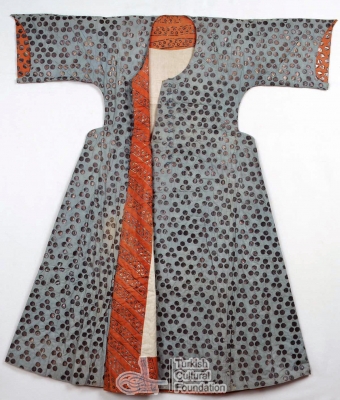Two triangular gores were inserted into the front opening of all robes. The most common style, used with all inner clothes and most overcoats, was for the gore on the right (the button side) to come up to the waist, and for the gore on the left (the buttonloop side) to come to the collar. This style allowed the closest fit through the torso. A looser style, used with some overcoats, was for both gores to come to the collar.
One Long, One Short • Two Long • Two Short
One Long, One Short
Two Long
Two Short
All the kaftan patterns currently kicking around the SCA call for two waist-length gores. This is a misinterpretation based on how kaftans are usually displayed: buttoned shut, with only the short gore visible. For example, here’s the usual photo of Ayşe Sultan’s late-16th-century kaftan:
[image]
Perfectly understandable that you’d conclude that both front gores are short. But here’s a photo of the kaftan partially opened:
The left side slants diagonally from the collar, not the waist. If the photo were better, you could see the vertical seam with buttonloops inserted into it. Here’s a detail of another famous kaftan, showing the seam and buttonloops:
[image]
The two-short-gore kaftan pattern has been around so long that I expect pushback from SCAdian traditionalists. Before you jump up with objections, pull out your stash of kaftan pics and ask yourself:
Is this a 16th- or early 17th-century kaftan? By the 18th century, women’s kaftans did indeed have two waist-length gores. Women’s styles changed so much between the early 17th century and the early 18th century that 18th-century women’s clothes are useless for even conjectural recreations of 16th-century styles.
Can I see any part of the garment where the left gore would be? Some kaftans button up so tightly that you can’t see the left gore at all. A photo isn’t useful as proof unless you can see the spot where a long left gore would be, or where a short left gore wouldn’t be.
If I can see part of the upper left side, is there a vertical seam? That seam is the join between the left front panel and the left gore. If it rises to the upper chest or the collar–whatever you can see in your photo–then the gore also rises at least that high. If the left gore rose only to the waist, then there wouldn’t be any need for a vertical seam at chest height on the left side.
If there’s no vertical seam, is the left side cut straight up and down? Sometimes the tailor had enough fabric to cut the front gores as a piece with the front panels. This is common with small children’s kaftans, less common but still possible with adults’ kaftans. In these cases, the garment is always closed with bars of braid, since there’s no seam to insert buttonloops into. When you run across this type of garment, ask:
- Can I see the edge of the left side? Is it straight up and down, or slanted?
- If I can’t see the edge, does the portion I can see cover the space where a straight-up-and-down edge should be?
- Do the rows of braid end the same distance from where I think the edge is, or do they fall progressively farther from the edge, as though the edge were slanting away from them?
Is the photo flipped horizontally? Photos from the Turkish Cultural Foundation Image Archive are sometimes flipped, making it seem that you’re looking at the left front panel when you’re looking at the right. Find other photos of the garment and use pattern details or small flaws to determine whether the photo is right-side-round.
If your photo passes all those tests, send it to me! I strive for accuracy. If I’m wrong and there really are period garments with two short front gores, I’ll correct my page immediately.




